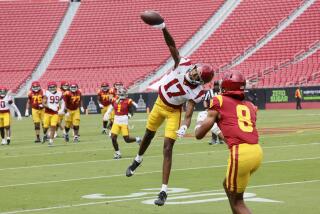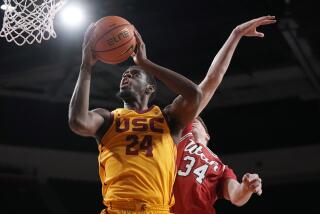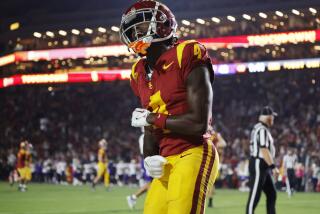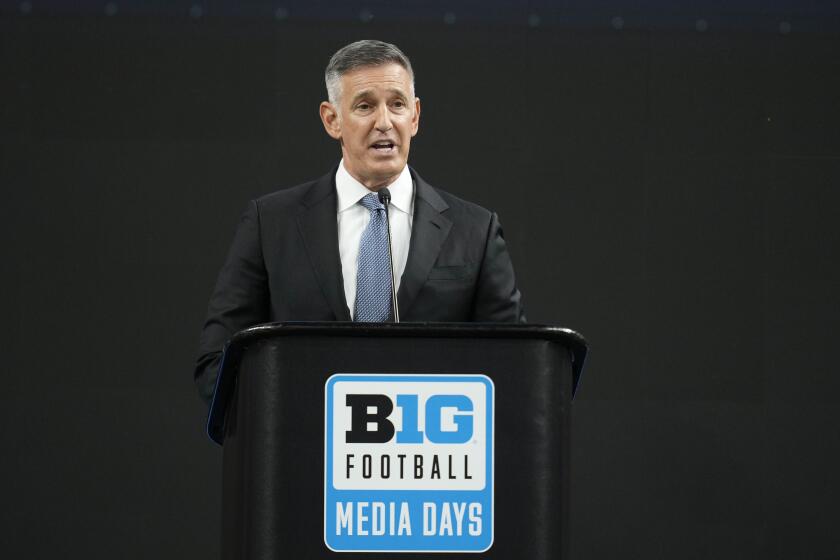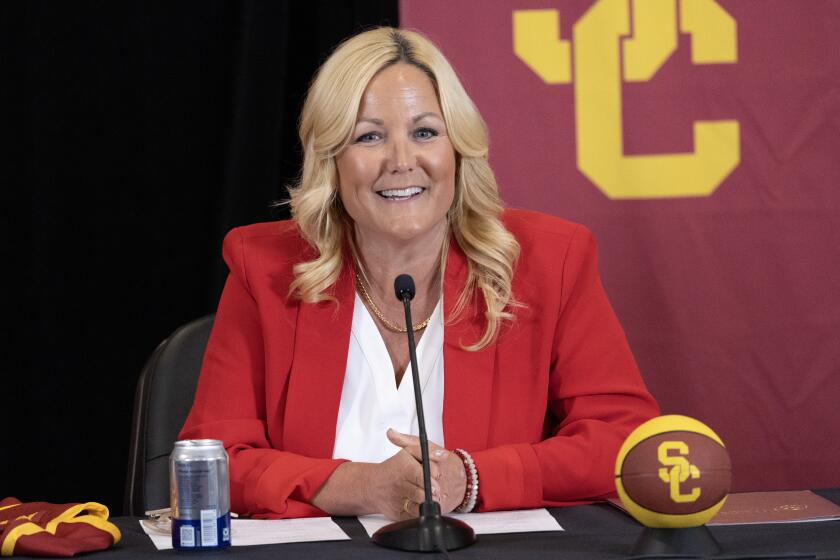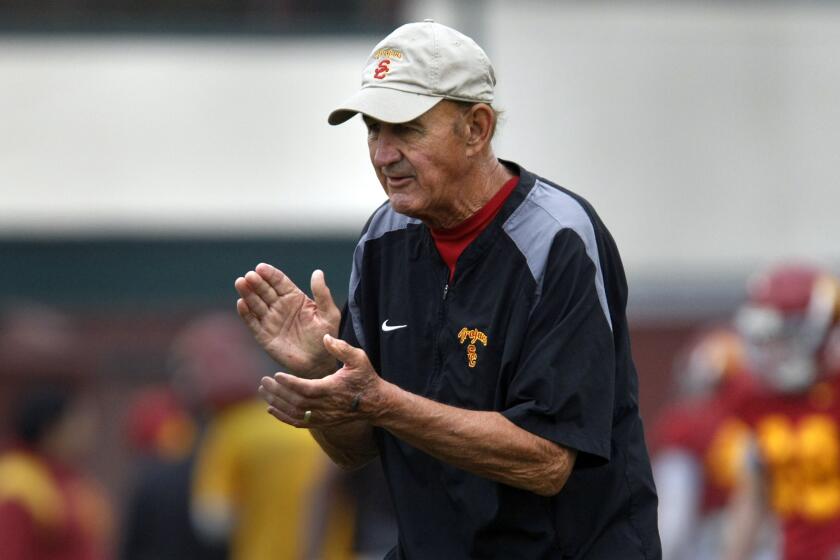Increased depth helps USC’s football team handle numerous injuries

USC wide receiver De’Quan Hampton makes a catch against Utah during a game on Oct. 24.
De’Quan Hampton acknowledged feeling impatient.
The receiver transferred from Long Beach City College to USC hoping to make an immediate impact, while knowing the Trojans had at least four returning receivers, another JC transfer, a quarterback converting to receiver and several incoming freshmen.
Hampton’s frustration increased after he did not play against Stanford or Washington. He asked receivers coach Tee Martin what he needed to do to play.
“He said, ‘Compete and be confident catching the ball,’ ” Hampton said.
Hampton followed through during practice last week and — with starters Steven Mitchell Jr. and Darreus Rogers and backup Isaac Whitney sidelined because of injuries — he came through with a key, 29-yard reception to set up a touchdown in the Trojans’ victory over previously unbeaten Utah.
Hampton was one of several reserves who filled important roles against the Utes, demonstrating that depth is no longer an issue — or an excuse — for a program two years removed from NCAA sanctions.
Former coach Steve Sarkisian said in September that “depth is our strength.” Interim Coach Clay Helton dipped deep into the depth chart against Utah and plans to continue doing so on Saturday at California and beyond.
Helton said it goes beyond having a near full complement of scholarship players. The Trojans opened the season with 81 scholarship players.
“It’s really important from a coaching standpoint that you trust those kids to make the plays and you call their number,” Helton said.
USC’s improved depth was most obvious against Utah on the offensive line.
With Chad Wheeler sidelined because of a concussion, Zach Banner moved from right tackle to left tackle. Freshman Chuma Edoga started at right tackle.
Toa Lobendahn, who had moved from guard to center after Max Tuerk suffered a season-ending knee injury, sustained his own season-ending knee injury during the first half and was replaced by Khaliel Rodgers.
“If you had [said] before the beginning of the year that we would beat Utah or the No. 3 team in the country minus three starters on the offensive line,” offensive line coach Bob Connelly said, “I’d have told you you were crazy.”
Rodgers, a fourth-year junior, said he remained confident he would get an opportunity.
“I believed it was going to come,” he said. “It’s football. ... People get hurt, injuries can happen anywhere on the field, so you just have to be ready.”
The Trojans tailback corps also is deeper.
In 2014, Javorius Allen carried the load with Justin Davis his only backup.
“Some things, we couldn’t do in practice because we didn’t have as many backs,” Davis said.
This season, Davis, Tre Madden and freshman Ronald Jones II have shared carries, with Adoree’ Jackson and freshmen Dominic Davis and Aca’Cedric Ware also getting a few.
Madden was sidelined against Utah because of a knee injury, so Justin Davis and Jones had most of the carries.
“They got it done and it allowed me to get my rest,” Madden said.
Jones is the Trojans’ leading rusher with 453 yards — “Every time he carries the ball it’s like he’s getting shot out of a cannon,” Madden said — but the Texas native reiterated this week that he was fine with his role as a backup and was working to improve his pass-catching skills.
“I can catch in practice but in the game I guess I get too excited and drop a ball here and there,” he said.
Helton said Jones’ role would continue to expand.
“Like we tell every player here, ‘As you produce and you put great stuff on film, your role increases,’ ” Helton said.
Hampton’s catch against Utah was the latest example of receiver depth. Freshman Deontay Burnett came off the bench at Notre Dame to catch two passes for significant gains and provide a key block that sprung Jones for a long gain.
Depth also is evident at linebacker and on the defensive line.
“We’ve got a lot of young guys who are very talented and stepping in and helping us out a lot,” senior Greg Townsend Jr. said.
Freshmen Rasheem Green, Noah Jefferson and Jacob Daniel often have played as a platoon in place of starters Townsend, Delvon Simmons and Antwaun Woods.
“It’s like coaching 2-year-olds sometimes,” defensive line coach Chris Wilson said. “Every time you think you’ve got it fixed, there’s something new you’ve got to fix.
“But they’re fun and they’re talented and they like to play.”
USC’s willingness to play the freshmen has enabled the Trojans to reduce the number of snaps starters play from more than 80 to between 60 and 70, Wilson said.
“That’s what you want,” Wilson said. “In most healthy programs that’s what it looks like.”
USC’s depth could be tested in the next few games against opponents such as Cal and Arizona that run up-tempo offenses.
But Helton is confident that younger players and those who have been in the program a few years will continue to step up.
“I think that’s a big part of it,” he said. “Let them do what they came here to do.”
Twitter: @latimesklein
More to Read
Go beyond the scoreboard
Get the latest on L.A.'s teams in the daily Sports Report newsletter.
You may occasionally receive promotional content from the Los Angeles Times.

